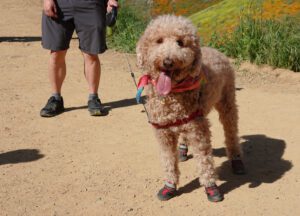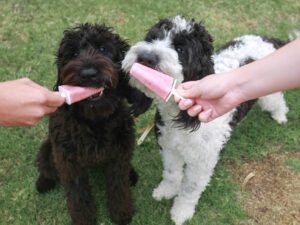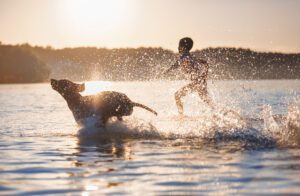The heat is on! Living in the desert has many benefits, but one major drawback is weathering the extreme temperatures. Our Ultimate Dog Heat Safety Guide is our resource to help keep your pup safe and happy this summer.
Dog Heat Safety on a Walk
Avoid the Hottest Hours
For both your dog’s safety and your own, you should avoid going out during the hottest parts of the day. Contrary to popular belief, temperatures do not peak at noon. Meteorologists state that temperatures are at their highest around 2PM-5PM every day. Similarly, the coolest time of day is in fact not in the evening, but in the morning. If it’s possible, try to take your dog out for their daily walks early in the day.
Practice Paw Safety

Air temperatures cool down as the sun starts to set. The same cannot be said for concrete and asphalt. Temperatures in Arizona can reach extremes so high that it can cause asphalt to melt slightly during the summer, and pavement retains heat for hours! For evening walks, always check the sidewalk before taking your dog out. Use the seven second rule; place the back of your hand on the sidewalk and hold it there for seven seconds. If you cannot do so comfortably, it is too hot for your dog’s bare paws. Even if the concrete temperatures are safe, try to give your dog’s paws breaks by allowing them to walk on any grass along your route.
Bring the Right Gear
Never leave the house without water for yourself and for your dog. Dehydration can set in at an alarming rate in the desert! Remember that your dog will need something to drink out of as well; consider a collapsible bowl, or travel dog water bottle. Dog boots are an excellent way to make sure your dog’s paws are protected. Cooling vests can be worn on walks to keep your dog from overheating. Did you know that they even make sunscreen for dogs? A little bit of investment can significantly improve your walking experience!
Watch for Overheating

Keep an eye on your dog’s behavior as you’re out and about. If your dog begins to pant excessively, become visibly tired, or becomes excessively thirsty, your dog may be experiencing heat stress. Find some place shady to rest and allow your dog to cool down and rehydrate.
Familiarize yourself with the symptoms of heat stroke using our article below. If you have reason to believe that your dog is experiencing heat stroke, this is a medical emergency. Transport your dog to the nearest vet as soon as possible.
Full article: Dog Heat Stroke Symptoms, Causes, and Treatment
Dog Heat Safety in the Home
Provide Fresh Water
Make sure that your dog has consistent access to clean water. Some dogs can become picky if water has sat out for too long, so make sure that you are rinsing their bowl and refilling it every day.
Caution: Gastric Torsion!

While staying hydrated is important, your dog drinking too much at once can cause its own problems. Certain breeds, especially larger breeds or those with deep chests, can be prone to gastric torsion (also known as bloat). This is a life-threatening condition that requires immediate veterinary attention! Prevent gastric torsion by limiting how much water is in your dog’s bowl and giving them time for the water to settle before refilling it. If your dog is notorious for drinking water rapidly, consider a slow-drink water bowl.
Make Sure Your Yard is Safe
We strongly urge you to avoid having your dog outside during the hottest periods of the day, or for prolonged periods at all during the summer months. In the event that your dog will be in your yard for more than a few minutes, make sure that your dog has both fresh water and adequate shade. Never leave a dog outside in a kennel during the summer. If your home has a pool, make sure that this pool is securely fenced off.
Speaking of Swimming…

Many dogs enjoy swimming, and it is an excellent way to help your dog exercise but stay cool during the summer! If you are interested in swimming with your dog, learn how to get started in our blog on teaching your dog to swim. If you are in the Phoenix area, one of our recommended dog trainers also offers swimming lessons. You can find her information on her website.
Full article: Teaching Your Dog to Swim: 6 Tips to Make Swimming Fun
Think Before You Shave!
You may look at your dog with their fur coat and worry that they would feel much better with less hair during these hot summer months. For some dogs, such as Poodles and Doodles, Maltese, or Shih-Tzus, they may appreciate a summer trim. However, many dog breeds such as Huskies, Golden Retrievers, Labradors, and more are double-coated. This means that their coats actually act as an insulator to help keep your dog cool! Shaving a double-coated dog breed can increase the dog’s risk of heat stroke, not to mention permanently damage their fur. Do some research on your dog’s breed before you fire up that razor – or, if in doubt, give us a call!
Beat the Heat with a Sweet Summer Treat!

Regular ice cream can make dogs sick, but did you know that you can make dog-friendly ice cream at home? A simple combination of frozen fruits or squash can be used to make frozen treats for your best buddy. Check out our blog for a few recipes!
Full article: Treat Your Dog To Healthy Ice Cream
Dog Heat Safety on the Go
Do Not Leave Your Dog in the Car!

Your dog should never be left alone in a car without air conditioning. Believe it or not, temperatures can become dangerous within mere minutes. On a 75°F day, the temperature inside a parked car can climb up to 104°F even with the windows down. During an Arizona summer where temperatures can regularly climb to over 115°F, leather seats or the dashboard can reach temperatures as high as 200°F! A dog can easily overheat or even die if left in these conditions. As much as your dog may love coming along for the ride, consider leaving your dog at home while you’re doing errands.
Research Dog-Friendly Hangouts

One of the only reasons that Arizona is habitable during the summer is because virtually every establishment is air conditioned. Did you know that a surprising number of places around the valley will allow you to bring your dog along? Look up dog friendly spots near you, or check out our list of places you can take your dog in the Phoenix area.
Full article: The Best Places for You and Your Dog in the Phoenix Area
Rattlesnake Avoidance

Rattlesnake season is at its peak from March to October! Keep your dog safe with rattlesnake avoidance training. It only takes about 20 minutes and it could save your dog’s life! Read more about rattlesnake training on our blog. You can also ask your vet about a rattlesnake venom vaccine.
Full article: Rattlesnake Training for Dogs
Lake Safety
Thinking of taking a trip up to the lake to cool down? Arizona is home to many beautiful lakes, and if your dog is a swimmer they will probably enjoy tagging along. Beyond normal swimming safety, there are two additional factors to consider when taking your dog out to swim in natural bodies of water. First, make sure to get a leptospirosis vaccine from your vet. Leptospirosis thrives is spread by wildlife and can be found in standing bodies of water such as puddles, ponds, and lakes. Getting an annual leptospirosis vaccine significantly reduces your dog’s risk.

Second, before you go, check to make sure that there are no active algal blooms. Blue-green algae can cause Harmful Algal Blooms (HABs) that can be dangerous to people and pets alike. If you observe algae while at the lake, avoid this area, discourage your dog from drinking the water, and be sure that both you and your dog rinse off thoroughly. Better to move to a different spot or pick a different lake than put your health at risk.
In Conclusion
The summer months are an intense time in the desert. With a little dog heat safety, you and your dog can survive – and even thrive! – until the temperatures cool down in the fall. Stay safe, stay cool, and have a great summer!



